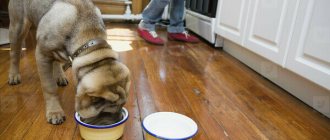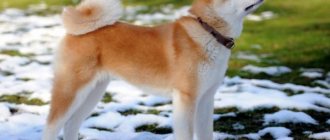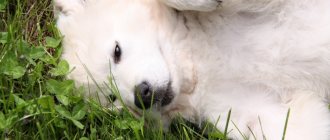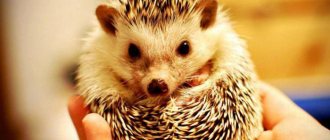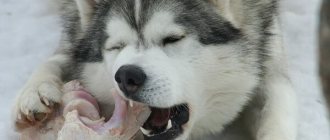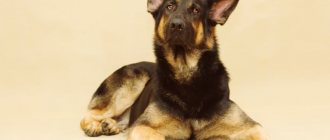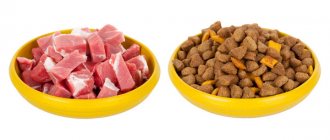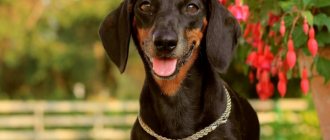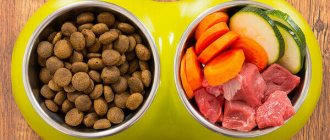Rottweilers are smart, hardy dogs with fairly large dimensions and a tendency to undergo serious physical activity.
The nutrition of these animals is one of the most important components of proper care for them. Their health and development, as well as life expectancy, depend on it.
Therefore, special attention must be paid to the preparation of the diet.
In order for representatives of this breed to have prominent muscles, a strong constitution and developed bones, it is necessary to create an optimal menu and strictly adhere to the feeding regime.
Natural food or artificial food?
Rottweiler puppies grow rapidly, so it is important that their diet is balanced and contains all the nutrients necessary for harmonious development.
Representatives of this breed can be fed with both natural products and artificial food, and it is better to decide on the type of feeding before purchasing a puppy .
Natural food is varied and does not contain artificial colors and flavors, but it requires the owner not only time and effort to prepare food, but also certain knowledge regarding the balance of nutrients and additives.
Ready-made industrial food is easy to use and has a balanced composition, but, based on the fact that Rottweilers cannot be fed with cheap food, they become a large expense item.
A mixed type of diet, combining natural products and ready-made food, as well as a sharp transition from one diet to another is unacceptable..
Expert opinion
Kozhevin Semyon Kirillovich
Expert dog handler.
Among professional breeders, feeding with prepared foods is more common due to their ease of use and the ability to save time. Moreover, each Rottweiler owner has the right to independently decide what and how to feed the pet. The main thing is that if you change the type of feeding, do not do it suddenly, and do not mix artificial nutrition and natural products. Industrial feeds contain all the necessary nutrients, vitamins and minerals, and additional consumption of natural products can lead to an excess of them, which can lead to digestive disorders, allergic reactions and other problems.
Breed Features
When taking a puppy into your home, you need to get acquainted in advance with all the nuances that nature can present. Having fallen in love with the four-legged Rottweiler, the characteristics of the breed are such that the animal cannot limit itself to 100 g of dry food or one egg. This dog is powerful, active, designed to protect the home and owner.
Rottweiler has:
- proportionally built body;
- strong muscles and bones;
- wide and powerful jaws;
- endurance;
- irrepressible energy;
- height at the withers of an adult dog is up to 65 cm;
- weight up to 50 kg.
At the same time, the dog moves easily and freely. Despite the “heaviness” of the body, the animal looks powerful, but graceful.
This is not to say that training is easy. The animal has its own character, shows strength and stubbornness. But with the help of treats you can take possession of your pet’s soul. Rottweilers have a sweet tooth and love to eat. This feature should be taken into account from an early age. Puppies require constant supervision when feeding.
Rapid weight gain with carbohydrate feeding is an unpleasant feature of the breed.
If the diet is structured correctly, then the animal can be easily and simply accustomed to the norm, and treats can be used as a means of training.
Pros and cons of natural food
With natural feeding, the owner chooses all the products that make up the dog’s diet independently, which minimizes the likelihood of the pet eating low-quality or stale food.
In addition, such nutrition has a number of other advantages.:
- a varied menu that does not contain preservatives, flavors, dyes, or flavor enhancers;
- in case of an allergy to one of the products, it can be replaced without a complete change of diet;
- all macro- and microelements contained in food are natural and easier to digest.
Also, feeding your pet with seasonal vegetables and fruits and periodically replacing beef with chicken can reduce financial costs.
We must not forget about the disadvantages of natural nutrition.:
- it is necessary to cook daily - food prepared for future use loses nutrients and can cause poisoning;
- learning how to create a balanced menu will take time;
- natural feeding involves additional intake of vitamins and minerals.
In addition, this type of food is inconvenient for those who often travel with their pet or simply do not have time for daily cooking..
Authorized Products
When choosing natural food, it is necessary to include in the Rottweiler's diet:
- raw or boiled meat for 5 minutes (beef, poultry);
- boiled offal (liver, kidneys, lungs, heart, udder) - 2 times a week as a complete replacement for meat;
- boiled sea fish – once every 3 days;
- boiled chicken eggs - 1-2 pcs weekly;
- oatmeal, rice and buckwheat porridge with water or meat broth;
- fermented milk products – low-fat cottage cheese, kefir, fermented baked milk, yogurt – 3-4 times a week;
- raw, boiled or stewed vegetables - beets, pumpkin, zucchini, cucumbers, broccoli, green beans;
- sunflower or olive oil – 2 gr. per 1 kg of dog weight daily to meet the need for vegetable fats.
With a competent approach to creating a menu, the pet receives with food all the substances necessary for growth and development.
However, you still need to add vitamins and minerals to your diet.
What is strictly contraindicated
| Product | Consequences of use |
| River fish | It has a lot of small bones, it is often infected with helminths, and many types of fish contain enzymes that destroy vitamin B and interfere with the absorption of iron |
| Sausages | Contain artificial colors, flavors, flavor enhancers, etc. |
| Sweets | Negatively affects vision |
| Tubular bones | Not digestible, can damage the stomach and intestines |
| Milk | In adults, it provokes gastrointestinal upset |
| Citrus | When storing them, biphenyl, methyl bromide and other substances undesirable for Rottweilers are used |
| Grape | Leads to bacteriosis |
| Pork | Fatty meat, a possible source of parasites dangerous to your pet |
| Pickles, smoked meats, spicy, fried foods | Negatively affects the stomach and liver |
| Legumes | Causes bloating and interferes with food digestion |
| Pearl barley | Cause of constipation |
| Boiled potatoes | Poorly digested, contains too much starch, promotes weight gain |
What not to feed
Rottweilers should not be fed the following foods:
- salted, pickled, fried foods;
- food with hot spices and herbs;
- sweets and bakery products;
- tubular bones;
- freshwater fish;
- sorrel, potatoes and legumes;
- fatty meat, sausages, sausages and smoked meats;
- grapes, raisins, avocados and citrus fruits;
- pasta.
Also, Rottweilers should not be given carbonated drinks, coffee and cocoa. Milk is contraindicated for adult animals because they cannot digest lactose, unlike puppies.
Industrial feed
Industrial feeds also have advantages and disadvantages.
The undoubted advantages include:
- contains all the necessary elements in the correct proportions;
- ease of use at home and travel;
- saving time due to the absence of the need for daily cooking;
- hygiene;
- availability of information on daily intake;
- long shelf life.
IMPORTANT!
It is also convenient that among a large assortment of industrial feeds, you can easily choose an option that suits the age, level of physical activity and health status of the dog.
If we are talking specifically about dry food, then their advantage is also a special composition covering the granules, which cleans the teeth of plaque and tartar.
Among the disadvantages of such feeding, the most common are::
- the likelihood of producing food based on low-quality meat and offal;
- the content of chemical additives in the form of flavors, taste enhancers and dyes in cheap feed.
Also, Rottweilers may be allergic to one or more food ingredients, most often as a result of improper selection of food or individual intolerance.
There are 2 types of ready-made food: dry and wet.
The second option has a higher cost and a shorter shelf life, so it is more often used by Rottweiler owners as a treat for their pet or as a reward for good behavior or correctly executed commands.
Wet food consists of 80% water, which significantly reduces its nutritional value.
It is allowed to combine 2 types of industrial feeds if they are produced by the same manufacturer and are part of the same line.
Depending on the composition and quality of the products used, ready-made feeds are divided into several classes:
- economy - made from low-quality ingredients, the meat in them is represented by the remnants of processing animal corpses, possibly containing soy, dyes, flavor enhancers, beans;
- premium - contains meat, offal and vegetables, but there is no guarantee of the presence of vitamins and minerals;
- super-premium - the composition includes the most carefully selected ingredients and a vitamin and mineral complex.
In addition, all manufacturers produce separate lines of hypoallergenic food containing rabbit, lamb, pike perch or salmon meat, vegetables and rice, and holistic food - food with a composition as close as possible to natural products.
What kind of porridge to cook for a Rottweiler
Rottweiler porridge is easy to prepare. It should make up about 35% of the main diet. However, before you start cooking, you need to learn a few recommendations from dog handlers. Not all grains are good for a dog's digestive system.
Porridges that are best suited:
- Buckwheat – supplies the pet’s body with vegetable protein, calcium, a whole complex of vitamins, iron, carbohydrates;
- Rice – this cereal contains a lot of magnesium, calcium, iron, as well as vitamins B and E;
- Oatmeal – contains vegetable fats and proteins, amino acids, vitamins and useful minerals. Some dogs may have an individual intolerance to this type of porridge, causing stomach upset;
- Wheat is an excellent source of energy for Rottweilers. Contains magnesium, iodine, zinc, vitamin complex – B, D, A, C. The dog’s intestines do not completely digest wheat kernels, but the remains serve as a kind of “brush” for cleaning it. It should be borne in mind that wheat chaff is best suited for dogs leading an active lifestyle. It gives a powerful boost of energy due to the presence of starch and flour in it.
- Barley – the dog’s body does not absorb the microelements it contains well. This applies to chromium and fluorine. It does not cause harm, but it is not considered very useful either. Can be a good way to replenish the energy reserves of a growing or overly active Rottweiler.
- Assorted – consists of three types of cereals, which are recommended for use in preparing porridges for dogs.
Some veterinarians advise cooking “lean” porridge and adding a little vegetable oil to it during the cooking process. Meat or offal is mixed into the finished porridge before feeding. Meat broth that is too rich can cause allergies due to excess protein. However, dogs kept outside can be given diluted broth, especially in the cold season.
What vegetables to dilute porridge with?
Porridges are good for satisfying a dog’s hunger, but not for fully providing valuable substances. They are supplemented with vegetables. Some vegetable crops are boiled together with porridge, others are ground raw and mixed before feeding. Salt, pepper, and improve the taste with spices are not allowed.
What porridges should a Rottweiler not cook:
- Wheat. Poorly digestible. It can even cause intestinal volvulus. Studies have shown that this cereal does not contain beneficial components for the dog’s body;
- Corn. Dog handlers have a negative attitude towards this type of cereal. They claim that feeding it to a dog is contraindicated. The exception is the animal's addiction to fresh or cooked corn cobs. In these cases, this porridge is given very rarely as a treat;
- Pearl barley. May cause a complex allergic reaction. The dog’s body practically does not absorb it;
- Manna. Carbohydrates in their purest form. Almost no vitamins or important microelements. The exception is when a newborn puppy is being fed or the dog has gastrointestinal problems.
Wheat porridge can also cause allergies. Therefore, dog breeders use it very carefully.
Dry food
Only high-quality food is suitable for feeding Rottweilers - at least premium class.
Professional breeders and experienced Rottweiler owners prefer food brands such as :
- Prima;
- Eukanuba;
- Hills;
- Royal Canin;
- Tropheo;
- Acana;
- Orijen.
The products they produce are of the highest class and have a wide range of breeds, made taking into account the heavy skeleton and developed muscles of Rottweilers and minimizing the risk of developing diseases of blood vessels and joints.
Rottweilers are large and fast-growing dogs, so their food should include::
- Omega-6 and Omega-3 fatty acids – to improve the quality of the coat;
- taurine, L-carnitine, vitamins E and C – for normal functioning of the heart and blood vessels;
- chondroprotectors - to avoid diseases and destruction of joints, maintain their mobility;
- proteins - for proper muscle development.
In addition, professional brands produce series designed for puppies (Starter, Junior) and specialized lines designed to suit various situations.
These are products made specifically for pets with sensitive digestion or excess weight, for nursing bitches or elderly and weakened dogs.
The transition to such food must be agreed with a veterinarian, because in fact, they represent a kind of diet, disease prevention.
Mode
You need to feed the puppy according to the schedule. The dog must know where, when and how much it can eat. Set aside a place for feeding, hang two stainless steel bowls for food and water on a special stand. Adjust the height of the stand to avoid curvature of the animal's spine - the bowls should be at shoulder level.
Feed your Rottweiler at the same time, removing food after fifteen minutes. Don't give supplements - don't encourage begging. The number of meals per day can be found in the following table:
Feeding the puppy
| Age | Required Products | Number of feedings |
| 0-2 months | In the first month, the puppy eats only mother's milk, then complementary foods are gradually introduced in the form of goat or sheep milk or milk porridge from crushed cereals | 6 |
| 2 months | Meat cut into small pieces, boiled eggs (maximum 2 per week), cottage cheese, fermented baked milk, yogurt, kefir, raw beef or veal cartilage bones, rye bread, buckwheat, rice, oatmeal | 5 |
| 3 months | Pre-frozen raw meat, grated cucumber, tomato, pumpkin, green apple | 5 |
| 4 months | Boiled sea fish without bones no more than 2 times a week instead of meat, milk (500 g), cereals, cottage cheese and vegetables (200 g each), meat (400 g) | 4 |
| 5 months | The daily meat intake is increased to 500 g, by-products are introduced - twice a week, replacing meat | 4 |
| 6-12 months | Meat (500 g), chicken egg (1 piece, 2 times a week), cottage cheese and vegetables (250 g each), porridge (300 g), vegetable fats (30 g) | 3 |
When feeding dry food for up to 6 months, it must be soaked in warm water or broth.
Natural diet
Feeding natural foods is closest to the physiology of a carnivore. Being a “butcher’s dog,” the Rottweiler’s ancestors knew no shortage of meat. Pure, high-quality protein has shaped the structure of the breed, and any carbohydrate feed introduces unnecessary adjustments. The dog gains excess weight and becomes lazy.
The puppy's diet should include:
- milk and dairy products;
- meat and meat products (including offal);
- fish;
- eggs.
A puppy's life begins with milk. If the dog brought into the house is 1-1.5 months old, then most likely he has already received additional complementary foods. You need to find out about this (what the puppy ate, how much, what food). If this information is not available, then offering him everything one by one in 1-2 days will make it easy to study your pet’s “culinary” preferences. At first, it is better not to deviate too much from your previous diet. New foods should be introduced gradually.
Milk and dairy products
The puppy's mother's milk is rich in fat, protein and calcium. Cow's milk is poorer, but during the growth period it will provide the necessary easily digestible minerals and proteins. The puppy should be offered milk. If he refuses fresh, offer yogurt or kefir. These products:
- will help the intestinal microflora develop;
- improve immunity;
- enrich the growing body with minerals.
Fermented milk cheese (cottage cheese) and sour cream are also excellent food. They should be included in the diet every day. Milk fat is a source of fat-soluble vitamins (A, D, E, K). They are the ones who will help hair growth and timely molting, visual acuity, and the formation of the reproductive system at a young age.
Feed should be introduced into the diet gradually. In this case, it is necessary to monitor the formation of fecal masses. If they are clearly formed, with a characteristic dog smell (without stench), everything is fine.
On store shelves you can find milk substitutes, milk-containing products and albumin-based dairy products. Such feeding will not be beneficial for the puppy’s body.
A separate place can be given to whey. An excellent fermented milk product is extremely beneficial for a growing body. Being a source of calcium and phosphorus when consumed daily, it can well balance the diet.
Milk and whey are not something to drink, they are food. They do not replace water.
Meat products
Meat products should account for 60% of the puppy’s daily diet. It is not necessary to feed your dog veal tenderloin, but meat is the basis of the diet.
The most optimal would be alternation:
- pork;
- beef;
- chicken;
- rabbit meat;
- lamb and goat meat;
- game.
All types of meat can be fed raw if they have passed a veterinary and sanitary examination. If the owner is a hunter and wild boar meat is in abundance, then it should not be fed raw or fried, especially giblets. It is necessary to boil such a product for at least an hour after boiling. This event will be a good prevention of trichinosis.
In order to reduce the cost of the diet, they resort to offal. They should not be given uncooked. Heat treatment should last at least 30 minutes from the moment of boiling.
You can include in your diet:
- heart;
- lungs;
- kidneys;
- cattle tripe;
- gizzards, liver and hearts of poultry;
- poultry broth sets.
Bones are essential food for a dog, and a growing organism as well. For a small puppy, give preference to the shoulder blade. The upper part, covered with cartilage tissue, is easy to bite through. It saturates the puppy well and is a valuable source of calcium and phosphorus.
The bones are voluminous. The stomach muscles cope quite well with this food. The dog remains full for a long time. If after eating bones the puppy refuses to eat food, this is normal, he is not hungry.
Eggs
The most balanced and valuable dog food is eggs. They contain:
- essential amino acids;
- fat-soluble vitamins (including Vit U);
- minerals.
A one-month-old puppy can easily eat one chicken egg. Don't deny him this. Eggs should be washed before feeding (prevention of salmonellosis). After feeding the egg, watch the puppy. If there is no reaction from the skin, and feces are formed, offer the product daily.
Fish
There is no need for expensive types of fish to feed a puppy. You can choose such as:
- sprat;
- herring;
- sardines;
- hake;
- pollock.
These types of fish are quite capable of satisfying the puppy’s body’s need for Omega-3 acids.
Before serving fish to your puppy, it should be boiled. There is no need to choose bones - they are a source of minerals.
Inland fish can cause helminthic infestation. It can be fed after boiling for at least 30 minutes after boiling, or abandoned altogether.
Carbohydrates
Of course, the puppy will beg for sugar, candy, and cookies. These products can get on the tongue, but only in tiny doses, in the form of a treat.
For a large dog, the owner often uses cereals in the form of porridges. They are not necessary. However, if you need to somehow fill up your diet, then practice sharing meals. At the same time you can boil:
- buckwheat;
- rice;
- pearl barley (barley);
- oatmeal.
Some dogs enjoy eating boiled potatoes. However, this does not mean that it should become a daily food.
It should be remembered that carbohydrates change the acid-base balance in the body of a carnivore - this can provoke a chlamydia infection. The little puppy doesn’t eat much and you can give up grains for now.
Advantages of natural feeding
By giving preference to natural products, the owner himself controls and balances the puppy’s intake of healthy nutrients. By introducing certain nutrients, using common sense, you can easily identify a product that is not suitable for a four-legged animal and remove it from the diet.
Natural feeding:
- more balanced;
- allows you to control the quality and quantity of certain components;
- carries “living” and useful biologically active substances and minerals.
Flaw
To create a diet and prepare food you need:
- time for purchase and processing;
- storage;
- energy and time to clean dishes and feeding areas.
Feeding an adult dog
Rottweilers that have reached 1 year of age should be fed twice a day.
NOTE!
In the case of natural nutrition, the daily food intake of a healthy representative of the breed should consist of 50% proteins, 30% carbohydrates and 20% fiber.
It is also necessary to take into account the pet’s level of physical activity: if he lives in an apartment and moves little, then he needs to eat no more than 800 g of meat, offal or fish, 2 kg of porridge and 300 g of vegetables per day.
If the Rottweiler has daily active physical activity and the dog lives in an enclosure, then the daily norm should be doubled, and for nursing bitches – 5 times.
The daily amount of food should be 5% of the dog’s total weight.
When feeding industrial food, it is necessary to select it taking into account the age of the dog, and the serving size must correspond to the manufacturer’s recommendations.
Mixed diet
Experienced dog breeders have long decided on a feeding strategy:
- the basis of the diet is natural food;
- if necessary, dry food.
This is the right strategy. It will allow you to feed the puppy in a balanced manner and allow the body to reach its optimum. Dry food can be used:
- when traveling;
- long walks;
- if it is not possible to prepare food.
When choosing dry food, you should pay attention to the manufacturer’s instructions, for what type of dog (large, small breeds) and age it is intended. It is better to purchase in small packaging (in case the food is not suitable). When feeding, you need to carefully monitor the animal (the condition of feces, skin and mucous membranes). If the puppy refuses to eat food, you should not force it (the food may be bitter, smelly, or unpleasant).
Vitamins and minerals
Among the wide range of vitamins and minerals presented in veterinary pharmacies, the most popular are::
- Canvit Junior - the drug contains a vitamin complex, organic elements, amino acids, polyunsaturated fatty acids; helps increase immunity, food digestibility and improve the quality of coat and skin;
- Polidex SyperWool – helps maintain the natural beauty of the coat, normalizes metabolic processes in skin tissue, and is used for the prevention and treatment of skin and coat diseases;
- “Liarsin” is a homeopathic medicine that improves coat and helps the functioning of the gastrointestinal tract, liver and kidneys;
- Canvit Chondro Maxi is a chondoprotector used for preventative purposes continuously for up to 2 years.
Excel Glucosamine 8 in 1 complex, consisting of glucosamine, calcium, phosphorus, vitamin C and other important microelements, also has good reviews.
Food selection
Having taken your future pet into your home, you need to take seriously the issues of raising and maintaining the puppy. As your household grows, you will become an expert in most topics related to our little brothers, and one of the main and first issues that you will face is the selection of food for the baby.
Eating mother's milk, the cubs received all the necessary microelements and nutrients, and now, when you bear responsibility for the life of the little ones, you need to think and decide what to feed the Rottweiler puppy in such a way as to preserve everything that nature has endowed the little one with and give him what he needs for proper and complete nutrition. growth and development.
One of the main topics of discussion, which is still open to this day, is the question of what kind of nutrition is more balanced and healthy. Each “contender” for the role of the best, and in particular food and so-called natural nutrition, has both its own differences and advantages with disadvantages, which we will now consider. I suggest we deviate from the topic of dogs and talk a little about you, their owners.
For most owners, a passion for animals is not the only hobby and activity; in addition to caring for and raising their pet, a person needs to attend work, communicate, pay attention to his family, if he has one, and, of course, do not forget about himself. But are you ready, in a series of all these responsibilities and events, to devote another part of your time to your ward, for selecting and preparing food for him?
Taboo in food
There are a number of foods that animals cannot accept for one reason or another. And in order not to harm your four-legged friend, you need to know them.
- Unprocessed cow's milk can lead to problems with the digestive system;
- legumes are difficult to digest and can cause bloating;
- cabbage is not recommended at an early age. Can be administered from six months of age, in heat-treated form;
- potatoes are simply not digestible for dogs; they contain too much starch;
- Sweets are another item that should be removed from the menu. Not only do sweets have a bad effect on your Rottweiler’s eyesight, they also cause obesity;
- tubular bones are not digested and can damage the walls of the stomach.
Of course, like any dog, the Rottweiler should not be given fried, fatty, spicy foods, foods with a high content of spices or alcohol, or a lot of flour. You cannot switch your animal to monotonous food; the diet must be simple, healthy and balanced so that the dog is well-fed and cheerful.
Source
Pedigree for healthy skin and coat, beef, 13 kg (for large breeds)
PEDIGREE helps reduce the risk of tartar and plaque formation on your pet’s teeth. Provides him with normal digestion. It is preferable to feed your pet dry food in a container separate from wet food, and ensure the availability of fresh drinking water. This is quite healthy, tasty dog food. It is produced taking into account the physiological needs of a large four-legged pet. The food is produced by a Russian company and is designed for the economy category.
pros
- Convenient packaging.
- Pleasant aromatic and taste properties.
- The pet eats with pleasure.
- No artificial flavors.
- High quality crackers.
- Comfortable in using.
- Lots of vitamins.
- The coat takes on a healthy, beautiful appearance.
Minuses
- Negative reputation.
- Missing useful components.
- Worse than normal nutrition.
- Doesn't do any good.
- Harmful to the health of the animal.
- The pet quickly gets used to this food and does not eat anything else.
- Increases salivation.
Vitamin and mineral supplements
Vitamin and mineral complexes are necessary for a dog if it is fed “natural”. A veterinarian will help you make your choice.
For the health of Rottweilers, it is important that the supplement contains substances such as calcium, phytin, retinol and vitamins D.
The drugs are well absorbed if mixed with fermented milk products.
Supplementation with vitamins must be done wisely. In summer you can do without medications. During the cold period, the body could use vitamin help.
CHAPPI MEAT ABUNDANCE WITH VEGETABLES AND HERBS, adults
CHAPPI is produced in Russia for economy class. It contains cereals, which are considered the best sources of carbohydrates. Proteins are present in the form of meat and offal. Use vegetables, for example, carrots, vegetable oils. CHAPPI is convenient because there is no need to add vitamins to it; they are already contained in sufficient quantities.
pros
- Wide availability.
- Nutritious food.
- Does not cause constipation in the animal.
- Decent quality.
- Promotes healthy appearance of coat and teeth.
- Doggies like it.
- There are no artificial flavors or flavor enhancers.
Minuses
- Treatment of the animal after eating these dry granules.
- Bad composition.
- Allergic reactions.
- Hair falls out.
- Bloating.
- Not suitable for all individuals.
- Unattractive packaging.
Belcando Junior Maxi for large and giant breed puppies from 3 to 18 months (15 kg)
Many experts recommend Belcando Junior, made in Germany, for large dogs. Its composition is rich in a high content of poultry meat, in addition to easily digestible rice, which helps good digestion and absorption of useful components. The recipe contains carob fruits, which contain tannins and substances important for life that have an effect on proper digestion. Belongs to the super premium class.
pros
- A complete, balanced complex of nutrients.
- Healthy pet.
- Convenient, economical packaging.
- A wide range of.
- Availability.
- German quality.
Minuses
- Causes an allergic reaction.
- Not all dogs like it.
- Not sold in all Russian cities.
- Composition with sodium chloride.
- Large granules of strange color.
- Poor combination with vitamins and other products.
- There is a minimum of meat, but a maximum of cereals.
Reviews
Denis, Vsevolozhsk
“I feed my pet only natural food. I prepare him porridge from boiled offal and millet. I also add a spoonful of tomato paste and vegetable oil to this dish. I mix vitamins into the evening portion. I rarely give vegetables. Rottweiler got allergies. I tried to switch to expensive good food, but the dog wouldn’t eat it. Apparently, he’s very used to his porridge.”
Alla, Chisinau
“My dogs are on a mixed diet. The veterinarian says that this is possible, and there is nothing wrong with it. In the morning I give dry food, in the evening I boil the tripe and trachea with oatmeal. They love to chew cucumbers and zucchini. We also feed with boiled eggs. For “sweets” I sometimes bake pumpkin with it. There have never been any consequences from such a diet.”
Useful video
From the video you will learn what to feed your Rottweiler:
The main principle on which a dog’s correct diet is based is maintaining a balanced diet. It is necessary to feed your Rottweiler so that he receives all the nutrients to maintain good health, but does not overeat. The tendency to gain excess weight, combined with an unbridled appetite, makes dogs of this breed real gluttons. They may whine and beg for more, but you cannot indulge their weaknesses.
There is no consensus among veterinarians about what type of food is best for Rottweilers. However, everyone agrees that when preparing a diet from natural products, it is important not to forget about additional vitamin and mineral complexes. Ready-made premium and super-premium food already contains all the necessary additives.
